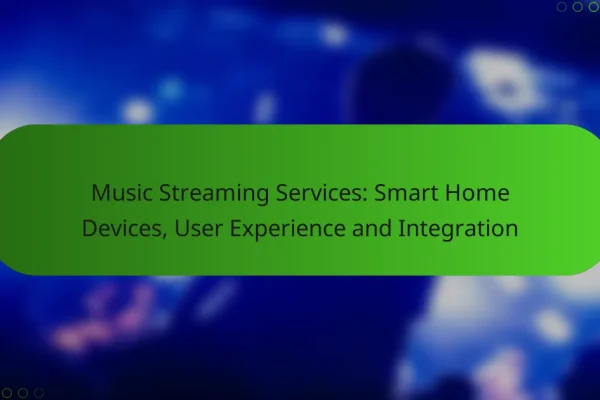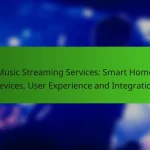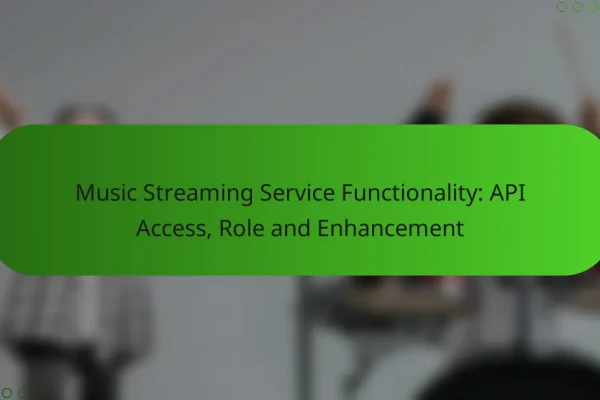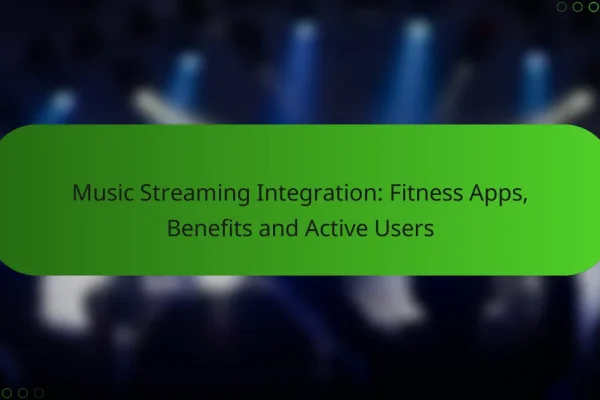How do music streaming services integrate with social media platforms?
Music streaming services integrate with social media platforms by allowing users to share their favorite tracks, playlists, and listening activities directly on their social feeds. This integration enhances user engagement and promotes music discovery among friends and followers.
Spotify and Facebook integration
Spotify’s integration with Facebook enables users to share songs and playlists on their profiles, making it easy for friends to discover new music. Users can connect their Spotify accounts to Facebook, allowing for automatic sharing of listening activity and collaborative playlists.
To maximize this integration, users should regularly update their playlists and engage with friends’ shared content. However, privacy settings should be managed carefully to control what is visible to others on Facebook.
Apple Music and Instagram sharing
Apple Music allows users to share songs and albums directly to Instagram Stories, providing a visually appealing way to showcase music preferences. This feature encourages followers to listen to shared tracks with a simple tap, increasing music engagement.
When using this feature, users should consider adding personalized captions or emojis to enhance their posts. It’s important to ensure that the shared content aligns with their brand or personal style to maintain authenticity.
What are the benefits of integrating music streaming with gaming platforms?
Integrating music streaming with gaming platforms enhances the overall experience for users by providing an immersive environment and personalized soundtracks. This synergy allows gamers to enjoy their favorite music while engaging in gameplay, creating a more dynamic and enjoyable atmosphere.
Enhanced user experience in Twitch
On Twitch, music streaming integration allows streamers to curate playlists that resonate with their audience, enhancing viewer engagement. Streamers can use licensed music to create a unique atmosphere, making their streams more entertaining and interactive.
Additionally, features like real-time song requests can involve viewers directly, encouraging participation and fostering community. Streamers should ensure they comply with copyright regulations to avoid potential issues with music rights.
Soundtrack integration in Fortnite
Fortnite has successfully integrated music streaming by allowing players to use their favorite tracks as background music during gameplay. This feature not only personalizes the gaming experience but also helps players feel more connected to the game.
Players can access various music options through partnerships with streaming services, enhancing the game’s vibrant atmosphere. However, it’s essential for players to be aware of any in-game purchases related to music tracks to manage their spending effectively.
How can businesses leverage music streaming integrations for advertising?
Businesses can effectively leverage music streaming integrations for advertising by utilizing targeted ads and forming brand partnerships. These strategies allow companies to reach specific audiences and enhance brand visibility through popular platforms like Spotify and Apple Music.
Targeted ads on Spotify
Spotify offers targeted advertising options that enable businesses to reach listeners based on their demographics, interests, and listening habits. Advertisers can create audio ads that play between songs, ensuring they capture the attention of users who are already engaged with the platform.
To maximize effectiveness, businesses should consider using Spotify’s audience insights to tailor their messaging. For instance, a fitness brand could target workout playlists to reach health-conscious listeners, increasing the likelihood of engagement and conversion.
Brand partnerships with Apple Music
Brand partnerships with Apple Music can enhance marketing efforts by creating unique promotional opportunities. Collaborating with Apple Music allows businesses to feature their products in curated playlists or exclusive artist content, fostering a deeper connection with potential customers.
When forming partnerships, brands should focus on aligning their values with those of the artists or playlists they choose to collaborate with. This alignment can lead to more authentic promotions and a stronger impact on the target audience, ultimately driving sales and brand loyalty.
What are the challenges of integrating music streaming with other platforms?
Integrating music streaming with other platforms presents several challenges, primarily related to licensing, technical compatibility, and user experience. These obstacles can hinder seamless access and functionality across different services.
Licensing issues
Licensing is a significant challenge when integrating music streaming services with other platforms. Each music track is subject to copyright laws, which require proper licensing agreements between the streaming service and rights holders. This can lead to complications, especially when attempting to share or embed music across different platforms.
For example, a platform that wants to include music from a streaming service must negotiate licenses for each track, which can be time-consuming and costly. Additionally, different countries have varying copyright regulations, complicating international integrations.
Technical compatibility
Technical compatibility is another major hurdle in music streaming integration. Different platforms may use varying technologies, APIs, and data formats, which can lead to difficulties in ensuring that music streams function correctly across all systems. Developers must often create custom solutions to bridge these gaps.
For instance, a music streaming service that uses a specific audio codec may not be compatible with a platform that supports only a different codec. Ensuring that both platforms can communicate effectively often requires extensive testing and development resources.
What criteria should businesses consider for effective integration?
Businesses should focus on user demographics, platform popularity, and technical compatibility when integrating music streaming with other platforms. Understanding these criteria helps ensure that the integration meets user needs and enhances overall engagement.
User demographics
Identifying user demographics is crucial for effective integration of music streaming services. Businesses should analyze the age, location, and preferences of their target audience to tailor the experience accordingly. For instance, younger users may prefer platforms like TikTok, while older demographics might lean towards Spotify or Apple Music.
Consider conducting surveys or utilizing analytics tools to gather data on user behavior and preferences. This information can guide decisions on which features to prioritize and how to market the integrated service effectively.
Platform popularity
Evaluating the popularity of various platforms is essential for successful integration. Popular platforms often have larger user bases, which can lead to increased visibility and engagement for the integrated music service. For example, integrating with widely used social media platforms can enhance user interaction and sharing capabilities.
Monitor trends and user feedback to identify which platforms are gaining traction. Aligning with popular services can maximize reach and ensure that the integration resonates with the intended audience. Additionally, consider the potential for partnerships or collaborations with these platforms to enhance the integration’s effectiveness.
How does music streaming integration impact user engagement?
Music streaming integration significantly enhances user engagement by providing a seamless experience across various platforms. This integration allows users to access their favorite music while interacting with other services, leading to increased satisfaction and retention.
Increased listening time
Integrating music streaming with other platforms can lead to longer listening sessions. For example, users may listen to music while using social media or gaming applications, resulting in extended engagement. This multi-tasking capability often translates to listening times that can increase by 20-40% compared to standalone music apps.
To maximize listening time, platforms should ensure easy access to music features, such as playlists or radio stations, without interrupting the primary activity. This can be achieved through features like background play or quick access buttons.
Social sharing boosts
Music streaming integration fosters social sharing, allowing users to share their favorite tracks or playlists directly through social media. This capability not only enhances user experience but also promotes the music itself, creating a viral effect that can increase the artist’s reach and listener base.
To encourage social sharing, platforms should implement user-friendly sharing options, such as one-click buttons for popular social networks. Additionally, incentivizing users with rewards for sharing can further enhance this engagement strategy.
What are emerging trends in music streaming integrations?
Emerging trends in music streaming integrations focus on enhancing user experience through advanced technologies and partnerships. These trends include AI-driven personalized playlists, seamless social media sharing, and integration with smart home devices.
AI-driven personalized playlists
AI-driven personalized playlists utilize algorithms to analyze user listening habits and preferences, creating tailored music experiences. By considering factors such as genre, mood, and time of day, these playlists adapt to individual tastes, making music discovery more engaging.
Many streaming services now offer features that automatically update playlists based on user interactions. For example, if a user frequently listens to upbeat tracks during workouts, the AI may prioritize similar songs in future recommendations. This dynamic approach keeps the listening experience fresh and relevant.
To maximize the benefits of AI-driven playlists, users should actively engage with the platform by liking or disliking songs. This feedback helps refine the algorithm, ensuring that the playlists evolve alongside changing preferences. However, users should be aware that relying solely on AI may limit exposure to new music outside their established tastes.









